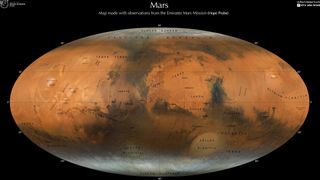
The United Arab Emirates’ Hope mission orbits Mars on a elliptical orbit that provides the spacecraft with unique views.
(Image credit: NYU Abu Dhabi)
New footage from Mars shows Red Planet dust reservoirs can send out huge clouds of material in a short time.
The Hope mission from the United Arab Emirates captured Mars images before and after a dust storm that show “discernible alterations on the surface,” officials with the Hope mission wrote on X, formerly Twitter, on Friday (Dec. 29), alongside an animation.
The spacecraft plotted changes in surface dust thickness following a regional dust storm in 2022, in part using infrared spectrometer observations that can look at heat signatures on the surface of Mars, according to a paper based on the results published in the Journal of Geophysical Research: Planets in October.
Related: UAE’s Hope Mars mission discovers patchy new aurora variety over Red Planet
The animation shows the spectrometer’s estimates of changes in surface dust thickness in the Isidis Planitia region, highlighted in red. This zone is a vast impact basin that is known to be filled with dust.
Hope examined several regions after a dust storm in January 2022, the paper stated, including Syrtis Major, Isidis Planitia, Tyrrhena Terra, Hesperian Planum, and Elysium Planitia. The researchers aimed to put “constraints on the amount of dust that was either lifted from or deposited onto these regions,” according to the paper.
“Although the regional dust storm was active over all the regions of interest, we found that dust may have been removed and subsequently deposited with varying levels of intensity in the regions sampled,” the researchers added.
The spectrometer measurements suggested that some of the regions had a net removal of dust as high as 340 μm or micrometers, representing surface temperature changes that could be seen in the spectrum from orbit. Other regions had net deposition of up to 120 μm.
“Visible-wavelength imagery from the Emirates Exploration Imager, which is more sensitive to changes in surface dust distribution, is incorporated in our analysis to provide additional context,” the researchers said. Their estimates thus revealed “dust reservoirs are capable of transporting vast quantities of dust over short timescales.”
Join our Space Forums to keep talking space on the latest missions, night sky and more! And if you have a news tip, correction or comment, let us know at: [email protected].
Breaking space news, the latest updates on rocket launches, skywatching events and more!
Elizabeth Howell (she/her), Ph.D., is a staff writer in the spaceflight channel since 2022 covering diversity, education and gaming as well. She was contributing writer for Space.com for 10 years before joining full-time. Elizabeth’s reporting includes multiple exclusives with the White House and Office of the Vice-President of the United States, an exclusive conversation with aspiring space tourist (and NSYNC bassist) Lance Bass, speaking several times with the International Space Station, witnessing five human spaceflight launches on two continents, flying parabolic, working inside a spacesuit, and participating in a simulated Mars mission. Her latest book, “Why Am I Taller?”, is co-written with astronaut Dave Williams. Elizabeth holds a Ph.D. and M.Sc. in Space Studies from the University of North Dakota, a Bachelor of Journalism from Canada’s Carleton University and a Bachelor of History from Canada’s Athabasca University. Elizabeth is also a post-secondary instructor in communications and science at several institutions since 2015; her experience includes developing and teaching an astronomy course at Canada’s Algonquin College (with Indigenous content as well) to more than 1,000 students since 2020. Elizabeth first got interested in space after watching the movie Apollo 13 in 1996, and still wants to be an astronaut someday. Mastodon: https://qoto.org/@howellspace
>>> Read full article>>>
Copyright for syndicated content belongs to the linked Source : Space.com – https://www.space.com/mars-spacecraft-dust-storm-tons-of-grains































